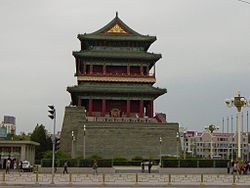This is an old revision of this page, as edited by Instantnood (talk | contribs) at 12:46, 25 January 2005. The present address (URL) is a permanent link to this revision, which may differ significantly from the current revision.
Revision as of 12:46, 25 January 2005 by Instantnood (talk | contribs)(diff) ← Previous revision | Latest revision (diff) | Newer revision → (diff)Tian'anmen Square (天安门广场; Traditional: 天安門廣場; Pinyin: Tiān'ānmén Guǎngchǎng) is a large paved public plaza near the middle of Beijing, China in front of the Forbidden City, facing south. Tian'anmen means "The Gate of Heavenly Peace", which is located north of the Square. The square is best known worldwide for the Tiananmen Square protests of 1989.

Built in 1417, the square is 880 metres south to north and 500 metres east to west. In 1651 (early Qing), the gate was renovated and renamed to its present form. During the Ming and Qing eras, there was no public square at Tiananmen, and instead the area was filled with offices for imperial ministries. These were badly damaged during the Boxer Rebellion and the area was cleared to produce the beginning of Tiananmen Square.
Enlarged in 1949 to 100 acres (400,000 m²), its flatness is broken only by the 38-metre-high Monument to the People's Heroes and Mao Zedong's mausoleum. It is lit with huge lamposts which also sport video cameras. The Great Hall of the People is on the western side of the Square. Qiánmén (Front Gate) is on the south side of the Square. National Museum of Chinese History is on the east side of the Square. Changan Avenue, which is used for parades, lies between Tiananmen Gate and the Square. Much part of the Square is open space with no trees or benches. Trees line the east and west edges of the Square. It is heavily monitored by uniformed and plainclothes policemen.
Tiananmen Square has been the site of a number of political events such as the proclamation of the People's Republic of China by Mao Zedong in October 1, 1949 and for mass rallies during the Cultural Revolution. It has also been the site of a number of protest movements, most notably the May Fourth Movement of 1919 for science and democracy, protests in 1976 after the death of Zhou Enlai, and the Tiananmen Square protests of 1989.
The protests of 1989 resulted in the killing of several thousand young Chinese in the square and adjacent areas and is thus called the Tiananmen Massacre.
Images from near and in the square



